by Lisa Cooke | Nov 1, 2017 | 01 What's New, Heirloom, History, Memory Lane |
Flour sack dresses show how resourceful housewives of the past “made do” with whatever was at hand. But they weren’t the only clever ones–see how savvy flour and feed companies responded to their customers’ desires for cuter sacking.
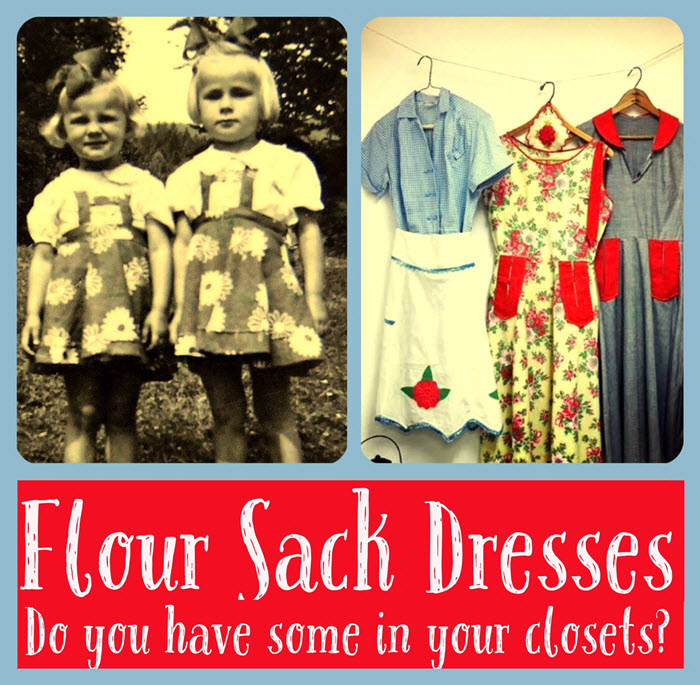
The History of Flour Sack Dresses
During the tough economic times of the Great Depression, housewives needed new ways to produce what their families needed, including clothing. So they looked around the house–and even the barn–for extra fabric they could turn into dresses, aprons, or shirts.
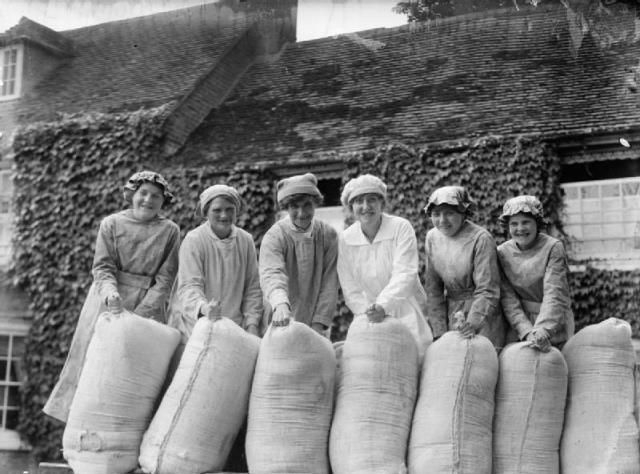
Female workers pose with sacks of flour in the grounds of a British mill during WWI. 1914. By Nicholls Horace [Public domain], via Wikimedia Commons. (Click to view.)
By the 1920s, these sacks had gotten a little cuter, some with gingham checked or striped patterns. So frugal housewives of the 1930s turned feed and flour sacks into everyday clothing for themselves and their families.
It didn’t take long for manufacturers of flour and feed to start printing their sacks with colors and patterns that women would want to buy. Some put patterns for dolls or stuffed animals on the bags. They even made it so you could wash out the ink so your new dress wouldn’t be a walking ad for Sunbonnet Sue flour! Newspapers and publishers also began printing patterns and ideas for getting the most out of the small yardage of a flour or feed sack.
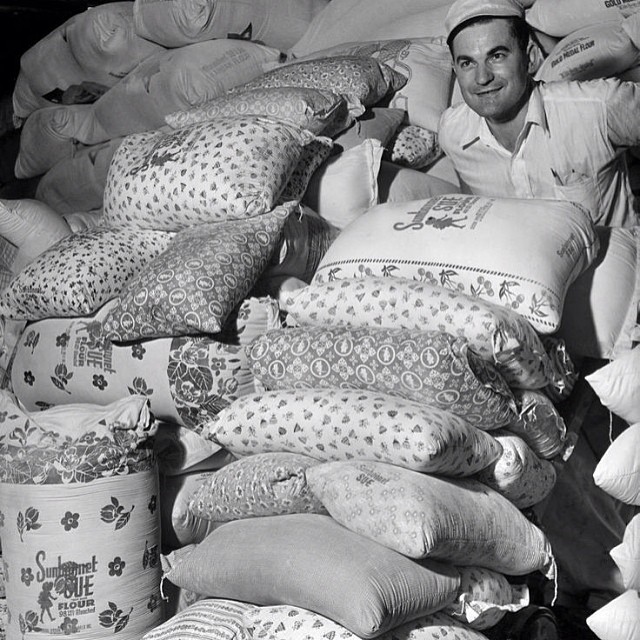
Old photo of printed fabric flour sacks or ‘feedsacks’. Flickr Creative Commons photo, uploaded by gina pina. Click to view.
A fascinating article at OldPhotoArchive.com shows some great images of flour and feed sack dresses. And the Smithsonian’s National Museum of American History has an online article about a feed sack dress from 1959, because these didn’t go out of fashion when the Great Depression ended! According to that article, World War II caused a cotton fabric shortage. Feed and flour sack dresses again became popular.

After the war, women continued to make these dresses, encouraged even further by national sewing contests. Women even sold off their extra flour or feed sacks to others who wanted them.
Memories of Flour Sack Dresses
A woman named Denise posted a neat memory at the end of the Smithsonian article. She says:
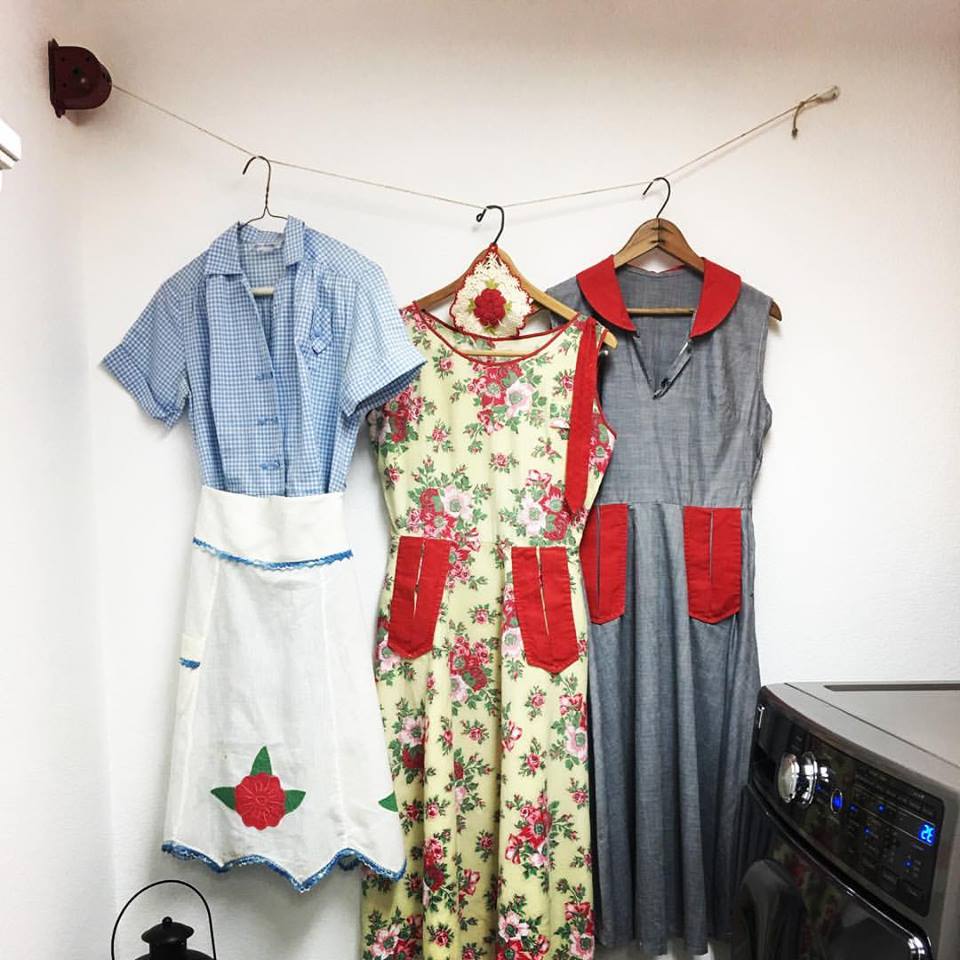
Click to view my Facebook post about my grandma’s 1940s house dresses.
“I was born in 1951. For the first four-five years of my life, all my dresses were sewn by my paternal grandmother from feed sacks. She would layer the fabric two to three layers deep and cut the main dresses from the same pattern. She would then add different details to each dress. Some sleeveless, some with little puffy fifties sleeves, some with self collars, some with contrasting solid collars. We lived in rural north GA, but nonetheless I was teased by my parents’ friends about my feed-sack dresses. Oh how I longed for store-bought dresses. Now, oh how I long to have some of those wonderful little feed sack dresses! They weren’t thought of as precious at all, so no one ever thought to keep them!”
I think a lot of people have fond—or at least vivid—memories of old dresses like these. I do! I posted a photo of my grandma’s old house dresses from the 1930s and 1940s on Instagram. What a response from everyone there and on Facebook! My grandma’s house dresses weren’t made from flour sacks, but they’re from the same era.
Want to see some eye-candy vintage fabrics or date your own family heirloom clothing? Check out these books:
Care for Your Flour Sack Dresses or Other Heirlooms
 Take better care of your own family heirloom pieces, whether they are photos, vintage fabrics, documents or other objects. Get Denise Levenick’s popular book How to Archive Family Keepsakes: Learn How to Preserve Family Photos, Memorabilia and Genealogy Records. This book will help you sort, identify, and preserve your own treasured family artifacts and memorabilia.
Take better care of your own family heirloom pieces, whether they are photos, vintage fabrics, documents or other objects. Get Denise Levenick’s popular book How to Archive Family Keepsakes: Learn How to Preserve Family Photos, Memorabilia and Genealogy Records. This book will help you sort, identify, and preserve your own treasured family artifacts and memorabilia.
Disclosure: This article contains affiliate links and Genealogy Gems will be compensated if you make a purchase after clicking on these links (at no additional cost to you). Thank you for supporting Genealogy Gems!
by Lisa Cooke | Apr 12, 2017 | 01 What's New, Heirloom
Some of us are using heirloom research for genealogy. A new exhibit traces the history of interesting heirlooms using genealogical research strategies. Be inspired by these examples and tips to research heirlooms and more fully discover their stories.
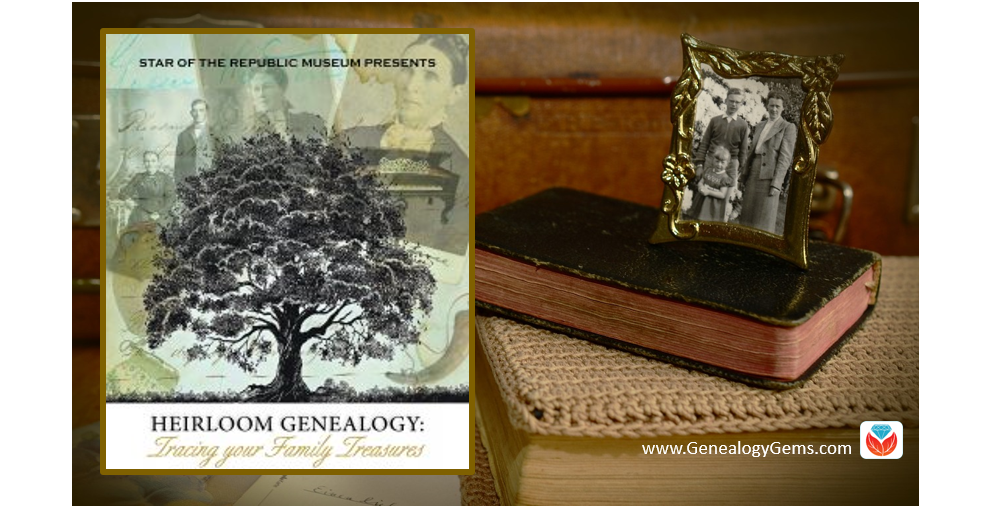
A new exhibit called Heirloom Genealogy: Tracing your Family Treasures has opened at The Star of the Republic Museum in Texas. You better believe it caught our interest! We know our readers are looking for unique and different ways to continue their genealogy journeys. We wanted to find out more about how family historians are using heirloom research for genealogy. Curator Shawn Carlson was kind enough to answer some questions about it and share the touching stories the heirlooms held.
Q: What an unusual exhibit idea! How did you think of it?
A: I had been researching artifacts at the museum for several years by tracing the genealogy of the families who donated the artifacts. The best exhibit text usually comes from real stories about artifacts—and doing the genealogy was where I found the stories. When I started thinking about this latest exhibit, I thought maybe there was a way that I could use the genealogical research I already had, and that’s when I came up with the idea of “heirloom genealogy.”
Q: Who was involved in the research and how long did it take?
A: I did all of the research. Some of it had previously been done, but some was new. I usually spend the summer researching for an exhibit, and then write the text and begin production in the fall for a March opening during the Texas Independence Day celebration at Washington-on-the-Brazos.
 Q: Can you share a couple of examples and images of artifacts and the documents that told their stories?
Q: Can you share a couple of examples and images of artifacts and the documents that told their stories?
A: One of the artifacts I researched was a red-on-white appliqué quilt. It was made in 1805 in Vermont and donated by the quiltmaker’s 3X great-granddaughter who lived in Houston. It should have been easy to figure out the lineage by the inscription on the quilt—but it wasn’t. There were two Cynthia Tuckers and two Pearl Browns in the family and one quilt owner had been married a couple of times and used a nickname. So, it took a bit of sorting out. The research was all done using census data, but it all came back to the inscription on the quilt for final verification.

Another item in our collection is a small buckskin suit that belonged to a little boy named Edward Clark Boylan. He was born in New Orleans in 1840 and died three years later near Galveston, probably from yellow fever. We knew his birth and death dates from his sister’s descendant who donated the suit, but not much else. I found some cryptic notes in our files taken by a previous curator and was able to trace Edward to Captain James Boylan who was captain of the ship Brutus during the Texas Revolution.
I found a passenger list from 1839 with Captain Boylan, his wife, and daughter traveling from Puerto Rico to New York. Mrs. Boylan would have been pregnant with Edward during that voyage:

The year that Edward died, his father was mentioned frequently in the newspapers as he led a flotilla of ships out of Campeche. He was probably not present when little Edward died.
Q: What was an especially interesting story you came across while researching this exhibition?
A: One of the most interesting items we’ve received in recent years is a slave birth record that was part of a family collection:

The donor’s ancestors were early settlers of Washington County. The slave record was interesting because it listed birth dates from 1832 to 1865. Out of curiosity, I tried tracking some of the slaves to see if I could find living descendants. I started with the 1870 census—looking for African-Americans with the surname of the plantation owner and first names that matched the slaves in the birth record. I was able to follow through on one of the names to find a living descendant. She and her family came to visit the museum and see the birth record of their ancestor. While the family was visiting during last year’s Texas Independence Day celebration, the donor of the slave record also visited the museum and the two families were able to meet.
Q: What advice do you have for family historians with heirlooms?
A: Learn about the artifacts you have and match them to their owners. There is plenty of information online that will help you identify and date artifacts. Knowing the date of an artifact helps you determine who had it in the past.
More on Heirloom Research for Genealogy
 Connect your heirlooms with their stories and bring the past to life!
Connect your heirlooms with their stories and bring the past to life!
Get Denise Levenick’s popular book How to Archive Family Keepsakes: Learn How to Preserve Family Photos, Memorabilia and Genealogy Records. This book will help you sort, identify, and preserve your own treasured family artifacts and memorabilia.
Disclosure: This article contains affiliate links and Genealogy Gems will be compensated if you make a purchase after clicking on these links (at no additional cost to you). Thank you for supporting Genealogy Gems!
by Lisa Cooke | Nov 25, 2014 | 01 What's New, British, Heirloom, Inspiration, Volunteer
 Thanks to an appeal on Facebook, an old World War I medal is back with its family!
Thanks to an appeal on Facebook, an old World War I medal is back with its family!
According to the North Devon Journal in the U.K., the medal was found with the belongings of a man who died in 1980. His sister only recently realized there was a name on the medal, says a story in the North Devon Gazette. She asked a nearby museum to help her return it to a living descendant.
A Facebook appeal went out for a descendant of the soldier, Private Albert Earnest Stowell, who the Gazette says served in the Devonshire Regiment.
Within half an hour a great great grandson of Private Stowell was located. The medal was returned to him at a museum ceremony.
Inspired? Click here for tips for how YOU can help orphaned heirlooms return to their families. More interested in learning more about your own family’s participation in World War I? Click here to read about Europeana’s online archive for WWI.
by Lisa Cooke | Apr 22, 2014 | 01 What's New, Craft & Displays, Inspiration
When my kids were little I would pack away some of their mountain of toys. Then every so often I would bring them back in to “play circulation” and pack up another batch. To the kids, it was like getting brand new toys!
Our recent move has been sort of like that. As I unpacked boxes of bubble-wrapped baubles it was like finding new family heirlooms all over again.
One example is quite small: a single vintage clip-on earring.
It belonged to my beloved Grandma Burkett. Even though it had lost its match long ago, I couldn’t bear to part with it. As I unwrapped the seemingly useless single earring I was immediately struck with how I could use it. I clipped it in my hair at the end of my french braid!
Later that day I went shopping with my daughter, and several people stopped to compliment the jewel and inquire about it. When I explained it originally belonged to my Grandmother, faces lit up and family history conversations started to flow. All from one little thing…
Your challenge this week: Look at what you have with fresh eyes, and share your family history with the world in little ways!
– Lisa
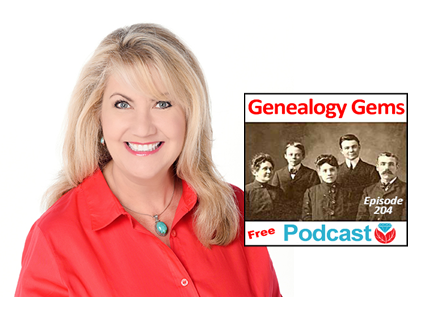
by Lisa Cooke | Oct 10, 2013 | 01 What's New, History, Inspiration, Military
A letter written to his infant daughter by an American soldier during World War II finally reached her–69 years later. She never knew him. He died in Italy in 1944.
A television station in Charleston, SC recently reported a woman’s reunion with this letter along with 16 other letters written to her mother, her father’s Purple Heart and Bronze Star medal and other personal effects. They’d been found years before in someone else’s attic, but it took this long for that person to locate his daughter, Peggy.
As a genealogist hearing this story, it reminds me to NEVER give up! You never know what evidence may be just around the corner (or in an attic), waiting to connect you with your relatives. It also makes me grateful for those genealogical good Samaritans–those who find important family artifacts and then work to reunite them with their long-lost families. Check out the video here:
 Feedsack Secrets: Fashion from Hard Times
Feedsack Secrets: Fashion from Hard Times




 Take better care of your own family heirloom pieces, whether they are photos, vintage fabrics, documents or other objects. Get Denise Levenick’s popular book How to Archive Family Keepsakes: Learn How to Preserve Family Photos, Memorabilia and Genealogy Records. This book will help you sort, identify, and preserve your own treasured family artifacts and memorabilia.
Take better care of your own family heirloom pieces, whether they are photos, vintage fabrics, documents or other objects. Get Denise Levenick’s popular book How to Archive Family Keepsakes: Learn How to Preserve Family Photos, Memorabilia and Genealogy Records. This book will help you sort, identify, and preserve your own treasured family artifacts and memorabilia.

 Q: Can you share a couple of examples and images of artifacts and the documents that told their stories?
Q: Can you share a couple of examples and images of artifacts and the documents that told their stories?


 Connect your heirlooms with their stories and bring the past to life!
Connect your heirlooms with their stories and bring the past to life!




